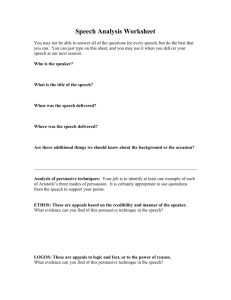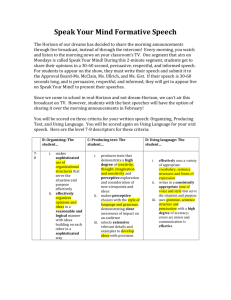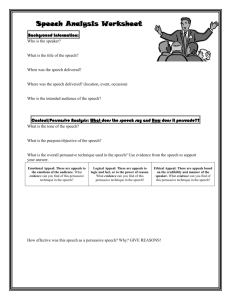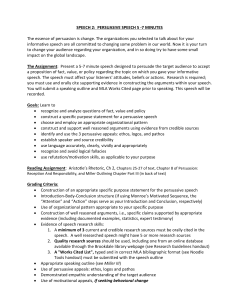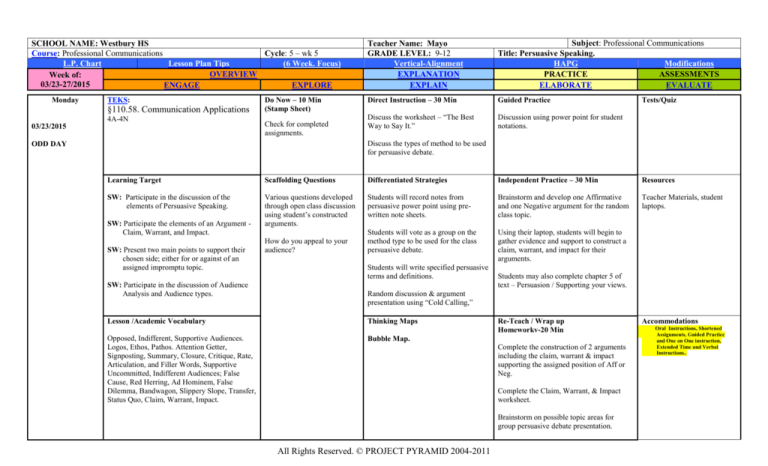
SCHOOL NAME: Westbury HS
Course: Professional Communications
Cycle: 5 – wk 5
L.P. Chart
Lesson Plan Tips
(6 Week. Focus)
OVERVIEW
Week of:
03/23-27/2015
ENGAGE
EXPLORE
Monday
TEKS:
§110.58. Communication Applications
4A-4N
03/23/2015
Do Now – 10 Min
(Stamp Sheet)
Check for completed
assignments.
Teacher Name: Mayo
GRADE LEVEL: 9-12
Vertical-Alignment
EXPLANATION
EXPLAIN
Subject: Professional Communications
Title: Persuasive Speaking.
HAPG
Modifications
PRACTICE
ASSESSMENTS
ELABORATE
EVALUATE
Direct Instruction – 30 Min
Guided Practice
Discuss the worksheet – “The Best
Way to Say It.”
Discussion using power point for student
notations.
Tests/Quiz
Discuss the types of method to be used
for persuasive debate.
ODD DAY
Learning Target
Scaffolding Questions
Differentiated Strategies
Independent Practice – 30 Min
Resources
SW: Participate in the discussion of the
elements of Persuasive Speaking.
Various questions developed
through open class discussion
using student’s constructed
arguments.
Students will record notes from
persuasive power point using prewritten note sheets.
Brainstorm and develop one Affirmative
and one Negative argument for the random
class topic.
Teacher Materials, student
laptops.
Students will vote as a group on the
method type to be used for the class
persuasive debate.
Using their laptop, students will begin to
gather evidence and support to construct a
claim, warrant, and impact for their
arguments.
SW: Participate the elements of an Argument Claim, Warrant, and Impact.
SW: Present two main points to support their
chosen side; either for or against of an
assigned impromptu topic.
SW: Participate in the discussion of Audience
Analysis and Audience types.
Lesson /Academic Vocabulary
Opposed, Indifferent, Supportive Audiences.
Logos, Ethos, Pathos. Attention Getter,
Signposting, Summary, Closure, Critique, Rate,
Articulation, and Filler Words, Supportive
Uncommitted, Indifferent Audiences; False
Cause, Red Herring, Ad Hominem, False
Dilemma, Bandwagon, Slippery Slope, Transfer,
Status Quo, Claim, Warrant, Impact.
How do you appeal to your
audience?
Students will write specified persuasive
terms and definitions.
Students may also complete chapter 5 of
text – Persuasion / Supporting your views.
Random discussion & argument
presentation using “Cold Calling,”
Thinking Maps
Re-Teach / Wrap up
Homeworkv-20 Min
Bubble Map.
Complete the construction of 2 arguments
including the claim, warrant & impact
supporting the assigned position of Aff or
Neg.
Complete the Claim, Warrant, & Impact
worksheet.
Brainstorm on possible topic areas for
group persuasive debate presentation.
All Rights Reserved. © PROJECT PYRAMID 2004-2011
Accommodations
Oral Instructions, Shortened
Assignments, Guided Practice
and One on One instruction,
Extended Time and Verbal
Instructions..
Tuesday
TEKS:
§110.58. Communication Applications
Do Now – 10 Min
(Stamp Sheet)
4A -4N
Check for completed
assignments.
03/24/2015
EVEN DAY
Direct Instruction – 30 Min
Guided Practice
Tests/Quiz
Using the student constructed
arguments from the assigned topic, the
class will analyze each argument for
the claim, warrant, and impact.
Discussion using power point for student
notations, and class discussion.
Student participation with the
discussion of constructed Aff
& Neg arguments.
Discuss the types of method to be used
for persuasive debate.
Learning Target
Scaffolding Questions
Differentiated Strategies.
Independent Practice – 30 Min
Resources.
SW: Present two main points to support their
chosen side; either for or against of an
assigned impromptu topic.
Various questions developed
through open class discussion
using student’s constructed
arguments.
Students will record notes from
persuasive power point using prewritten note sheets.
Students will be grouped at random to
complete the “Lost at Sea” group persuasive
activity.
Teacher Materials, student
laptops.
Students will vote as a group on the
method type to be used for the class
persuasive debate.
Students will brain storm on general topic
areas to be used for the group persuasive
debate presentation.
Students will write specified persuasive
terms and definitions.
Students will complete chapter 5 of text –
Persuasive speaking / supporting your
views.
SW: Participate in the discussion of Audience
Analysis and Audience types.
SW: Participate in the discussion of persuasive
Speech construction and outlining.
Lesson /Academic Vocabulary
Opposed, Indifferent, Supportive Audiences.
Logos, Ethos, Pathos. Attention Getter,
Signposting, Summary, Closure, Critique, Rate,
Articulation, and Filler Words, Supportive
Uncommitted, Indifferent Audiences; False
Cause, Red Herring, Ad Hominem, False
Dilemma, Bandwagon, Slippery Slope, Transfer,
Status Quo, Claim, Warrant, Impact.
How do you appeal to your
audience?
Random discussion & argument
presentation using “Cold Calling,”
Thinking Maps
Re-Teach / Wrap up
Homeworkv-20 Min
Bubble Map
Write down the “To Remember” questions
to be answered.
All Rights Reserved. © PROJECT PYRAMID 2004-2011
Accommodations
Oral Instructions, Shortened
Assignments, Guided Practice
and One on One instruction,
Extended Time and Verbal
Instructions.
Wednesday
TEKS:
§110.58. Communication Applications
4A -4N
03/25/2015
Do Now – 10 Min
(Stamp Sheet)
Check for completed
assignments.
ODD DAY
Direct Instruction – 30 Min
Guided Practice
Tests/Quiz
Using the student constructed
arguments from the assigned topic, the
class will analyze each argument for
the claim, warrant, and impact.
Discussion using power point for student
notations, and class discussion.
Student participation with the
discussion of constructed Aff
& Neg arguments.
Discuss the types of method to be used
for persuasive debate.
Learning Target
Scaffolding Questions
Differentiated Strategies
Independent Practice – 30 Min
Resources
SW: Present two main points to support their
chosen side; either for or against of an
assigned impromptu topic.
Various questions developed
through open class discussion
using student’s constructed
arguments.
Students will record notes from
persuasive power point using prewritten note sheets.
Students will be grouped at random to
complete the “Lost at Sea” group persuasive
activity.
Teacher resources and student
laptops.
Students will vote as a group on the
method type to be used for the class
persuasive debate.
Students will brain storm on general topic
areas to be used for the group persuasive
debate presentation.
Students will write specified persuasive
terms and definitions.
Students will complete chapter 5 of text –
Persuasive speaking / supporting your
views.
SW: Participate in the discussion of Audience
Analysis and Audience types.
SW: Participate in the discussion of persuasive
Speech construction and outlining.
Lesson /Academic Vocabulary
Opposed, Indifferent, Supportive Audiences.
Logos, Ethos, Pathos. Attention Getter,
Signposting, Summary, Closure, Critique, Rate,
Articulation, and Filler Words, Supportive
Uncommitted, Indifferent Audiences; False
Cause, Red Herring, Ad Hominem, False
Dilemma, Bandwagon, Slippery Slope, Transfer,
Status Quo, Claim, Warrant, Impact.
How do you appeal to your
audience?
Random discussion & argument
presentation using “Cold Calling,”
Thinking Maps
Re-Teach / Wrap up
Homeworkv-20 Min
Bubble Map
Write down the “To Remember” questions
to be answered.
All Rights Reserved. © PROJECT PYRAMID 2004-2011
Accommodations
Oral Instructions, Shortened
Assignments, Guided Practice
and One on One instruction,
Extended Time and Verbal
Instructions.
Thursday
TEKS:
§110.58. Communication Applications
Do Now – 10 Min
(Stamp Sheet)
4A -4N
Check for completed
assignments.
03/26/2015
EVEN DAY
Direct Instruction – 30 Min
Guided Practice
Tests/Quiz
Review speech types.
Teacher direct questions based upon the
students arguments.
Objective: to see how the student(s)
defend their argument.
Audience types Quiz.
Discussion how to construct a
persuasive speech using the persuasive
template.
Discuss the elements of a speech.
Discuss student responses from the “To
Remember” questions from chapter 5.
Learning Target
Scaffolding Questions
Differentiated Strategies
Independent Practice – 30 Min
Resources
SW: Continue the discussion of persuasive
Speech construction and outlining with
emphasis on the attention getter &
signposting.
How do you appeal to your
audience?
Student note taking.
Students will complete chapter 5 of text –
Persuasive speaking / supporting your
views.
Teacher resources and student
laptops.
Kahoot.
SW: Begin to collaborate in a small group to
develop persuasive team arguments.
How do you know your
argument to persuade is
strong?
Lesson /Academic Vocabulary
Opposed, Indifferent, Supportive Audiences.
Logos, Ethos, Pathos. Attention Getter,
Signposting, Summary, Closure, Critique, Rate,
Articulation, and Filler Words, Supportive
Uncommitted, Indifferent Audiences; False
Cause, Red Herring, Ad Hominem, False
Dilemma, Bandwagon, Slippery Slope, Transfer,
Status Quo, Claim, Warrant, Impact.
How do you persuade?
Students will present their general ideas
for the group persuasive presentation.
Class will vote for the general topic.
Students will be randomly paired.
Thinking Maps
Student teams will begin to brainstorm and
analyze possible arguments for the topic.
Each team will develop arguments for the
Aff & Neg side. Topic position will be
later assigned.
Re-Teach / Wrap up
Homeworkv-20 Min
Bubble Map
Using the Bubble Map, create 4 arguments
for the class topic.
Create and develop a Bubble map for the
topic.
All Rights Reserved. © PROJECT PYRAMID 2004-2011
Accommodations
Oral Instructions, Shortened
Assignments, Guided Practice
and One on One instruction,
Extended Time and Verbal
Instructions.
Friday
§110.58. Communication
Applications 4A -4N
TEKS:
Do Now – 10 Min
(Stamp Sheet)
Check for completed
assignments.
03/27/2015
ODD DAY
Direct Instruction – 30 Min
Guided Practice
Tests/Quiz
Review speech types.
Teacher direct questions based upon the
students arguments.
Objective: to see how the student(s)
defend their argument.
Audience types Quiz.
Discussion how to construct a
persuasive speech using the persuasive
template.
Discuss the elements of a speech.
Discuss student responses from the “To
Remember” questions from chapter 5.
Learning Target
Scaffolding Questions
Differentiated Strategies
Independent Practice – 30 Min
Resources
SW: Continue the discussion of persuasive
Speech construction and outlining with
emphasis on the attention getter &
signposting.
How do you appeal to your
audience?
Student note taking.
Students will complete chapter 5 of text –
Persuasive speaking / supporting your
views.
Student laptops & Teacher
resources.
Kahoot.
SW: Begin to collaborate in a small group to
develop persuasive team arguments.
How do you know your
argument to persuade is
strong?
How do you persuade?
Students will present their general ideas
for the group persuasive presentation.
Class will vote for the general topic.
Students will be randomly paired.
Lesson /Academic Vocabulary
Thinking Maps
Opposed, Indifferent, Supportive Audiences.
Logos, Ethos, Pathos. Attention Getter,
Signposting, Summary, Closure, Critique, Rate,
Articulation, and Filler Words, Supportive
Uncommitted, Indifferent Audiences; False
Cause, Red Herring, Ad Hominem, False
Dilemma, Bandwagon, Slippery Slope, Transfer,
Status Quo, Claim, Warrant, Impact.
Bubble Map
Student teams will begin to brainstorm and
analyze possible arguments for the topic.
Each team will develop arguments for the
Aff & Neg side. Topic position will be
later assigned.
Re-Teach / Wrap up
Homeworkv-20 Min
Using the Bubble Map, create 4 arguments
for the class topic.
Create and develop a Bubble map for the
topic.
All Rights Reserved. © PROJECT PYRAMID 2004-2011
Accommodations
Oral Instructions, Shortened
Assignments, Guided Practice
and One on One instruction,
Extended Time and Verbal
Instructions.
All Rights Reserved. © PROJECT PYRAMID 2004-2011


